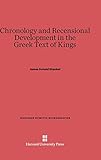Chronology and Recensional Development in the Greek Text of Kings / James Donald Shenkel.
Material type: TextSeries: Harvard Semitic Monographs ; 1Publisher: Cambridge, MA : Harvard University Press, [2013]Copyright date: ©1968Edition: Reprint 2014Description: 1 online resource (151 p.)Content type:
TextSeries: Harvard Semitic Monographs ; 1Publisher: Cambridge, MA : Harvard University Press, [2013]Copyright date: ©1968Edition: Reprint 2014Description: 1 online resource (151 p.)Content type: - 9780674433311
- 9780674433328
- 222/.5
- BS1325.2
- online - DeGruyter
| Item type | Current library | Call number | URL | Status | Notes | Barcode | |
|---|---|---|---|---|---|---|---|
 eBook
eBook
|
Biblioteca "Angelicum" Pont. Univ. S.Tommaso d'Aquino Nuvola online | online - DeGruyter (Browse shelf(Opens below)) | Online access | Not for loan (Accesso limitato) | Accesso per gli utenti autorizzati / Access for authorized users | (dgr)9780674433328 |
Frontmatter -- PREFACE -- CONTENTS -- ABBREVIATIONS -- INTRODUCTION -- CHAPTER I. Recensional Development in the Greek Text of Samuel and Kings -- CHAPTER II. Chronologies in the Books of Kings -- CHAPTER III. The Regnal Formula of Jehoshaphat -- CHAPTER IV. The Reigns from Ahab to Ahaziah (J) -- CHAPTER V. The Chronology of the Prophetic Narratives -- CONCLUSION -- APPENDIX A. -- APPENDIX Β. -- Notes to Introduction -- Notes to Chapter I. -- Notes to Chapter II. -- Notes to Chapter III. -- Notes to Chapter IV. -- Notes to Chapter V. -- Notes to Appendix A. -- Bibliography -- INDEX
restricted access online access with authorization star
http://purl.org/coar/access_right/c_16ec
This first volume in the Harvard Semitic Monographs series challenges many of the standard positions that have long been held concerning the Greek and Hebrew texts of the Books of Kings. The author's personal examination of the Qumran Hebrew manuscripts, published and unpublished, has led to a new understanding of the recensional development of the Greek text. His study contributes significantly to the methodology of modern textual criticism and the evaluation of historical sources in the Old Testament. Examining the parallel development of the Greek text and the Hebrew, the author attributes the chronological discrepancy between the oldest Greek text forms and the Masoretic text to a change from the chronological system found in the Hebrew Vorlagen of the Old Greek and proto-Lucian texts to the newer system of the Masoretic text. The greatest difference between the two systems is found in the period from Omri to Jehu, where the pattern of regional formulae is worked into the narratives concerning Elijah and Elisha. The author concludes that the reason for the change to the newer Masoretic system was the desire to be able, from a chronological viewpoint, to identify Jehoshaphat as the King of Judah in the narrative of the Moabite campaign, an identification that was not possible in the older Greek chronology.
Mode of access: Internet via World Wide Web.
In English.
Description based on online resource; title from PDF title page (publisher's Web site, viewed 29. Nov 2021)


